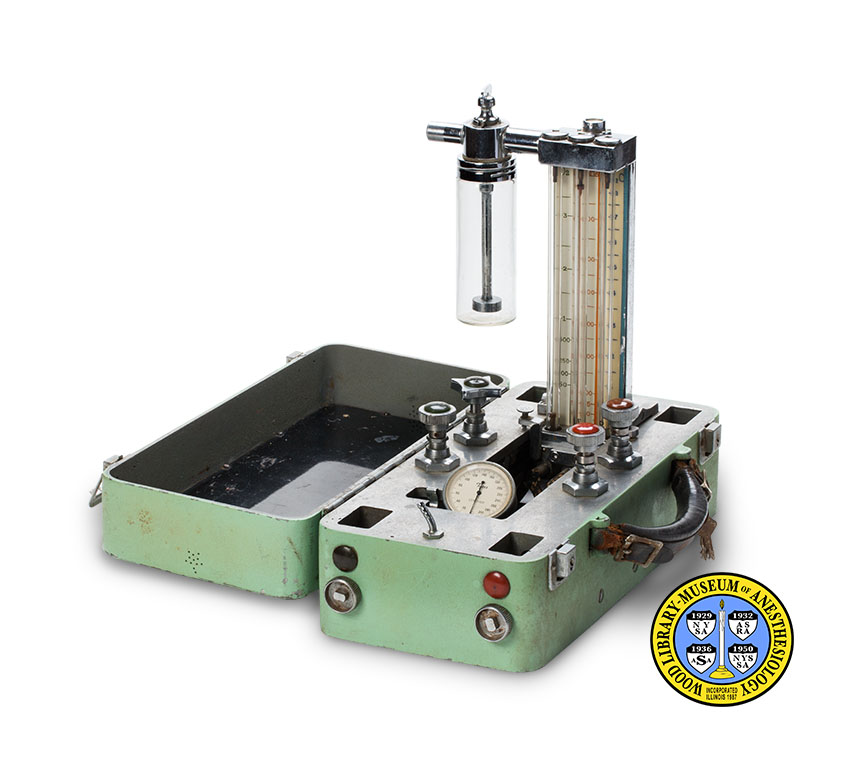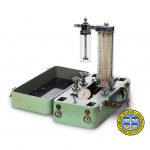Magic Box
Foregger Magic Box
The Magic Box was also known as the Portable Rotameter Midget. The Foregger Company used this now-antiquated word to emphasize the small size and portability of the device. Introduced in 1949, this was one of the first Foregger models to feature the type of flowmeter called a rotameter. Rotameters had been used on anesthesia machines in Great Britain for about a decade before the Foregger Company began to offer them. The company’s owner, Richard von Foregger, preferred the water depression flowmeters that he had developed for his anesthesia machines. Many American anesthesiologists gained experience using rotameters during the Second World War and returned home with a preference for them. One who advocated this change in design was the owner’s own son, Major Richard Foregger, M.D.
The Magic Box was constructed in a metal case. It had a rotameter bank that could be folded down into the case for transport and storage. The Magic Box was made with four yokes, and one rotameter each for oxygen, nitrous oxide and cyclopropane. It came with a vaporizer attachment and a manometer for use with a blood pressure cuff. The case could be supported on the attached gas cylinders alone, or on a stand, and had a "water bubble scale" to aid in leveling the rotameter bank. Compare this to Foregger’s Australian model.
Catalog Record: Magic Box
Access Key: almp
Accession No.: 880011 (McKechnie)
Title: [Portable rotameter midget : the magic box] / Foregger.
Corporate Author: Foregger Company.
Title variation: Alt Title
Title: Portable rotameter midget.
Title variation: Not Applicable
Title: Foregger magic box.
Publisher: [New York] : Foregger, [between 1949 and 1957?].
Physical Descript: 1 anesthesia machine : metals, plastics, glass, leather, rubber ; 33.5 x 43.5 x 38 cm.
Subject: Flowmeters.
Subject: Cyclopropane.
Note Type: General
Notes: The early year in the date range for the possible year of manufacture of this
“Magic Box” (portable rotameter) is based on the first catalog in which the
Magic Box is found and on a history of the Foregger rotameter provided by the
manufacturer’s son Richard Foregger in a 2001 article publlished in Der
Anesthesist. The end date is also based on the article my Mr. Foregger and
Foregger Company catalogs. The Magic Box is in the 1956 catalog but not in
the 1958 catalog.
Note Type: Citation
Notes: Ball C, Westhorpe R. The rotameter. Anaesth Intensive Care. 1999;27(6):553.
Note Type: Citation
Notes: Ball C, Westhorpe R. The water depression flowmeter. Anaesth Intensive Care.
1999;27(3):237.
Note Type: Citation
Notes: Catalog No. 14. New York: The Foregger Company, Inc.; 1956:38.
Note Type: Citation
Notes: Catalog No. 15. Roslyn Heights, New York: The Foregger Company, Inc.; 1958.
[The Magic Box is not in the catalog.]
Note Type: Citation
Notes: Foregger R. The rotameter and the waterwheel. Anaesthesist.
2001;50(9):701-708.
Note Type: Citation
Notes: Foregger R. The rotameter in anesthesia. Anesthesiology. 1946;7:549-557.
Note Type: Physical Description
Notes: One portable rotameter in a metal carrying case; The measurements provided in
the physical description field are of the open case, with the rotameter
upright; For the purposes of this description the ‘front’ of the apparatus is
based on the direction in which the rotameter faces (If it were based on the
case and where the handle is attached, one might say that the rotameter faces
the left side, and that in this description the left side is being treated as
the front); The sides of the case are painted a sea foam green color, and it
has a leather handle and two latches on the right side of the base; The top
of the case is black and bears the manufacturer’s marking, “FOREGGER”; A
punch-label is on the right side of the top: “MCKECHNIE”; The top of the case
is hinged to the bottom on the left side of the case; When closed the case
measures approximately 14.5 x 21.5 x 38 cm; Circular openings in the bottom
of the case allow for the attachment of the case to a pole, as well as to gas
cylinders; Inside is a rotameter-type flowmeter bank which is collapsible
for portability; The rotameter is extended upright for use; There is a meter
for oxygen, cyclopropane, and nitrous oxide; There are four yokes for gas
canisters; Each yoke has an accompanying turn knob; One turn knob is green
and labeled “O2”, another is red and labeled C3H6, and another is brown and
labeled N2O; A fourth yoke and knob is not labeled; Inside the case, between
the O2 and C2H6 yokes is a Tycos pressure gauze marked in “mm” with a tick
mark for every 10 mm and numbers for every 20 mm from 20 to 300; A metal and
glass ether vaporizer attaches to the left side of the rotameter.
Note Type: Reproduction
Notes: Photographed by Mr. Steve Donisch November 12, 2014.
Note Type: Historical
Notes: Called the “Portable Rotameter Midget,” and “The Magic Box,” this apparatus
was one of a line of Foregger “Midget” anesthesia machines. The Foregger
Company of Roslyn, New York used the now-antiquated word, midget, to
emphasize the small size and portability of the machines.
The Magic Box first appeared in the 1949 Foregger catalog. This was also the
first Foregger catalog to feature the type of flowmeter called a rotameter.
Rotameters had been used with anesthesia machines in Great Britain for about
a decade before the Foregger Company began to offer them. The owner, Richard
von Foregger, preferred the water depression flowmeters that he had developed
for anesthesia machines. Many American anesthesiologists gained experience
using rotameters during the Second World War and returned home with a
preference for them.
Rotameters were constructed with carefully tapered glass tubes, mounted so
that the end with the larger diameter was at the top. The tubes were marked
with or accompanied by numbered scales. Inside the tube was a bobbin, also
called a float. Tiny spherical grooves were cut on the bobbin so that gas
flowed through the tube and around the bobbin, causing it to rotate. The
rotation centered the bobbin in the tube and reduced contact and friction
between the bobbin and the inner wall of the tube. The location of the bobbin
in relation to the scale reflected the rate at which the gas was flowing.
Rotameters had to be placed in a truly vertical position in order to measure
gas flow accurately.
The Magic Box was constructed in a metal case. It had a rotameter bank that
could be folded down into the case for transport and storage. The Magic Box
was made with four yokes, and one rotameter each for oxygen, nitrous oxide
and cyclopropane. It came with a vaporizer attachment and a manometer for use
with a blood pressure cuff. The case could be supported on gas cylinders
after attachment, or on a pole. The box also held a “water bubble scale” to
aid in leveling the rotameter bank. The Magic Box is not found in Foregger
catalogs after 1956.
Note Type: Acquisition
Notes: Donated to the WLM by Franklin B. McKechnie, MD (1919-2003). Dr. McKechnie
was president of the American Society of Anesthesiologists in 1986.
Note Type: Exhibition
Notes: Exhibited at the National World War II Museum in New Orleans, October, 2014.


